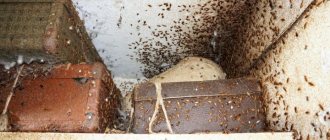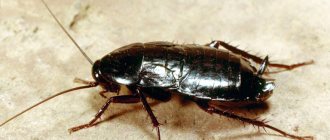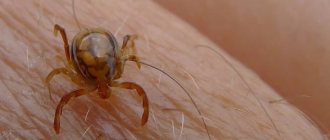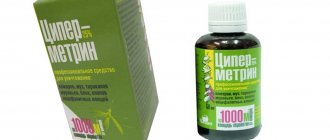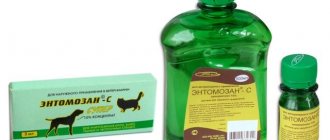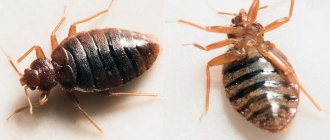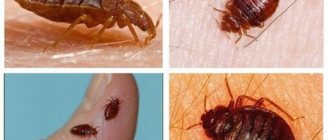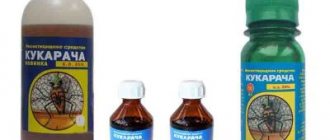Composition and principle of action of cypermethrin
The work of the insecticide is based on a paralytic mechanism of action on the nervous system of insects; it is effective against both adults and their larvae. Cypermethrin, the active substance of which consists of a mixture of various modifications of cyclopropanecarboxylic acid ester, due to the peculiarities of its composition, cypermethrin is resistant to light and atmospheric oxygen.
Strict adherence to instructions and dosages guarantees achievement of the desired result and long-lasting effect on the treated area.
Purpose and principle of operation
Cypermethrin is a neurotoxic poison. Penetrating into the body of insects through the integument, the substance disrupts the transmission of nerve impulses, which causes organ paralysis and death. The working solution lasts a long time on treated surfaces, as it is resistant to ultraviolet radiation and high temperatures. The protective effect lasts for one and a half to two weeks. The drug also has a repellent effect on insects and rodents.
Most often, drugs are used to protect plants from stem flies, bread beetles, cereal aphids, Colorado potato beetles, and leaf rollers. Indoors, the products are used to kill bedbugs, mosquitoes, ticks and cockroaches.
Types of the drug and release forms
Cypermethrin in its pure form is a transparent, colorless liquid with a specific odor.
Insecticidal products based on it, available to the end consumer, can be:
- water soluble powder;
- wettable powder;
- mother liquor;
- concentrated emulsion;
- pills.
More than 200 different drugs containing cypermethrin are produced worldwide. About 50 of them are for domestic use.
Alpha
Alpha-cypermethrin is a racemic mixture based only on cis-isomers of the base substance. This is a viscous, colorless mixture that has a long-lasting effect and is effective at all stages of insect development. The drug is resistant to climate change and does not enter groundwater. Safe for bees, birds and mammals.
Beta
Beta-cypermethrin is a racemic mixture of cis and trans isomers in a ratio of approximately 40:60. Physically it is a white crystalline powder, which is practically insoluble in water, but is easily diluted in organic solvents. Most often used against larvae and adult insects. Dangerous for bees and fish, moderately dangerous for humans.
Zeta
Zeta-cypermethrin is a racemic mixture consisting of both cis and trans isomers, containing the 4 most active isomers with the S configuration of the cyano group. Unlike all other modifications, it is an optically active substance. It is a dark brown mixture that has good solubility in most organic solvents.
When used correctly, the drug is practically safe for humans and non-toxic for bees.
Pros and cons of the product
Cypermethrin is the best of the most commonly used products. But this drug also has its drawbacks that must be taken into account.
Table 4. Pros and cons of the drug
| Advantages | Flaws |
|
|
The effectiveness lies in the fact that parasites do not develop immunity to Cypermethrin, as they do to other insecticides.
Pest control effectiveness
Various insecticidal preparations based on cypermethrin have been used for many years in various industries and have proven themselves to be a reliable product. For more effective use of the drug and causing the least possible harm to others, first determine the places of maximum accumulation of insects. Based on the experience of using cypermethrin, standard methods for working with the most common insects have been developed.
Bedbugs
The destruction of bedbugs is carried out using an aqueous emulsion of an insecticide with a concentration of 0.01%. The drug is used to treat all surfaces where insects can enter.
The most thorough treatment is carried out in the area:
- skirting boards;
- door blocks;
- carpets and runners on both front and back sides;
- places where laminate and wallpaper are peeling off;
- all possible cracks and unevenness of the floor and walls.
A bedbug repellent based on cypermethrin emulsion is most effective if preliminary work is carried out correctly to identify places where parasites accumulate and live. It is prohibited to use cypermethrin for treating bedding.
Cockroaches
When treating a room against cockroaches, an aqueous emulsion with a concentration of 0.1% is used. The composition is applied to all surfaces accessible to insects, including possible paths of insects to food and water.
Mosquitoes
To combat mosquitoes, an emulsion of the drug with a concentration of 0.01% is used. To achieve the desired effect, the insecticide is sprayed on areas where insects frequently accumulate, the walls of houses and places where garbage accumulates.
Fleas and ticks
For ticks and fleas, cypermethrin is used in the form of an aqueous emulsion with a concentration of 0.1%. The product is sprayed on walls, baseboards and floors to a height of up to 1 m. Particular attention is paid to the treatment of cracks and various irregularities.
Ants
When fighting ants, an insecticide emulsion containing 0.01% of the drug is used. Special attention should be paid to areas of compact habitat and accumulation of insects, as well as ant “paths” along which insects move.
Price
Insect repellent is available for sale, and the price is determined by the packaging volume:
- 100 ml will cost 490 rubles;
- 1 l – 1150 rub.;
- 5 l – 4.5 thousand rubles.
Analogs of products based on Cypermethrin can be bought cheaper - 50 ml of Medilis-Cyper will cost 150 rubles, and 1 tablet of Inta Vir costs 7 rubles.
The presence of small insects in the house causes not only a feeling of discomfort - parasites can cause the development of infectious diseases. In this case, Cypermethrin is the No. 1 universal insecticide that quickly and effectively solves the problem. But given its toxicity, it is important to follow safety rules.
Comparative characteristics of the repellent with other drugs
Compared to other insecticides, cypermethrin has relatively low toxicity to humans, and therefore is available for use by non-professionals. In addition, it is not addictive to insects, which is important for regular use. In low concentrations, preparations based on it not only destroy, but also repel insects.
There is only one significant drawback of cypermethrin - the insecticide does not act on insect eggs.
A drug similar in scope, chlorpyrifos, is a more effective, but very toxic insecticide, available only to professionals and is usually used in agriculture or for sanitary treatment. Unlike cypermethrin, it destroys insect eggs. What is better to use - chlorpyrifos or cypermethrin - is determined individually, based on the circumstances of each situation.
Instructions for use
If professional pest control is carried out, in this case workers use equipment such as quasar, automax, and backpack sprayers. It is important to ensure that microscopic particles exit the nozzle: from 20 to 150 microns. In domestic conditions, it is impossible to obtain a small-sized suspension, since it is inappropriate to purchase expensive equipment for one-time cleaning of a home. For this reason, household sprayers are used. Sequence of actions:
- The prepared solution is poured into a bottle with a spray bottle (a glass cleaner container).
- Close windows and doors. To enhance the effect of the drug, seal the ventilation grill with tape.
- The product should be sprayed at a distance of 20 cm from surfaces.
- All pieces of furniture and household appliances are subjected to treatment: stove, refrigerator, microwave, cabinets. Moreover, you need to remember that poison cannot be sprayed inside electrical appliances; the poison is applied exclusively to the back walls. Cabinets can be treated both outside and inside.
- Cypermethrin is sprayed along the baseboards, along the perimeter of the door frame and window blocks.
- The floors and walls behind large furniture and appliances are also treated.
- The product is sprayed over any cracks: in the floor, near sewer and water pipes.
- After treatment, open the windows and doors, and ventilate the room for a long time.
- At the last stage, the contact areas with which the person is constantly in contact are wiped. General cleaning is performed no earlier than after 1 month.
It is not recommended to process woven materials. The procedure is repeated after 2 weeks.
Method of application and consumption rates
The most common method of using the drug is spraying an aqueous emulsion with a concentration of up to 0.1% inclusive. The use of more concentrated solutions requires the participation of professionals. Various emulsions are commercially available. The most concentrated option available to non-professionals is cypermethrin 25 (the instructions for use state that the number corresponds to the content of the active insecticide). Cypermethrin instructions for use provide for preliminary preparation of the solution.
The consumption rates of the finished emulsion depend on the type of insects being destroyed:
- against cockroaches, bedbugs and fleas: 0.1% solution, 50 ml./sq.m. non-absorbent surface and 100 ml./sq.m. for absorbent;
- against flies: 0.01% solution 100 ml/sq.m.;
- from ants: 0.05% solution 50 ml./sq.m.;
- from hornets and wasps: 0.1% solution 100-200 ml./sq.m.
Reviews
Products for combating various types of insects produced on the basis of cypermethrin are included in the category of fairly popular compositions. Such control agents are characterized by a rapid effect on parasites with subsequent preservation of insecticidal properties for a long time. Since the drugs have a medium toxicity class, poisoning is possible only if safety precautions are not followed, as well as the instructions for using the drugs are ignored. You should also not enter the room before the specified time.
Drugs of this class have been working for decades. At the same time, they have proven themselves to be effective, capable of coping with many types of dangerous insects that prevent a person from feeling comfortable in their home. A wide range of cypermethrin-based products allows you to make the optimal choice, taking into account specific conditions of use, and affordable prices make such drugs accessible to a wide range of customers. This factor has a decisive influence on the choice of these particular funds.
Professional insect control products are produced based on cypermethrin and are used by teams of exterminators. Such compositions make it possible to get rid of various types of harmful insects both in apartments and houses, as well as in public spaces, in vegetable gardens and gardens. The main thing is to ensure conditions for the safe use of toxic substances to reduce the likelihood of poisoning.
Duration of protection and re-treatment
The duration of action is 10-15 days. The greatest effectiveness is achieved during the first 2-3 hours. Upholstered furniture and vegetation retain cypermethrin for up to 3 weeks, heavy soils - up to 10 weeks, finishing materials and light soils - up to 4 weeks. With proper processing, the period of protection of cypermethrin from bedbugs is 1.5 months, reviews confirm this, and from cockroaches - about 60 days.
The need for re-treatment is determined individually in each individual case and depends on the effectiveness of the initial measures taken. If parasites appear after the end of the period of action of the insecticide, additional treatment with the insecticide is carried out.
Storage and transportation
Cypermethrin is flammable. It is stored in tightly closed containers in warehouses. Heating and heating devices should not be located near the drug. The packaging must indicate the date of manufacture and expiration date.
The insecticide purchased for the home should be stored indoors, where children and animals cannot enter. There should be no food, dishes, medicines or clothing in the room. It is best to place the package with the product in a closet or drawer. The temperature in the room can vary from -10° to +30°C.
During storage, you must carefully monitor the integrity of the container.
The working solution is prepared at a temperature not higher than +28°C. There should be no sources of fire in the room. The prepared emulsion cannot be stored. It must be used within 8 hours of preparation.
The drug can be transported in any type of covered transport in accordance with the rules for the carriage of goods. The product is transported at temperatures from -30° to +35°C.
Toxicity of the drug and safety precautions
Cypermethrin-based drugs belong to toxicity classes 2 and 3 due to their high danger to humans.
If used incorrectly, poisoning, severe neurotoxic and allergic reactions are possible, characterized by the following symptoms:
- gait disturbance;
- slow reaction;
- salivation;
- convulsions.
Cypermethrin vapors are explosive, and the substance itself ignites at temperatures above 300 degrees Celsius, and therefore the use of the drug is prohibited near open fire sources and hot objects.
The permissible concentrations of the drug are:
- residential air: 0.01 mg/cub.m;
- human body: 0.01 mg/kg;
- natural reservoirs: 0.4 mg/cub.m;
- open air: 0.006 mg/cub.m;
- soil: 0.02 mg/kg.
When treating with insecticide, the following precautions must be observed:
- The occupants of the premises are removed to a safe place for at least a day.
- Children, nursing and pregnant women, people with allergies can move into the treated premises after at least 3-4 days.
- In the room being treated, as well as in the immediate vicinity, all work involving the use of welding and open fire is stopped, heating and electrical appliances are turned off.
- The presence of a source of clean air, exhaust and ventilation in the room is checked.
When treating premises with air aerosol mixtures, the following personal protective equipment is mandatory:
- Jumpsuit made of thick water-repellent fabric with a tightly sewn hood.
- Full-face respirator. To purify the air, a gas cartridge of grade “A” must be used.
- Technical rubber gloves. The use of medical and household gloves is strictly prohibited.
- Protective sealed glasses of monoblock type.
- Rubber boots.
Only clean protective clothing may be used. After completing the work, all used products and tools are transferred to a separate non-residential area and washed in the shower. The surfaces of gloves, boots, glasses and a respirator must be cleaned with a soap solution and then rinsed with clean water. Clothing should be washed in a soda ash solution (5 mg/liter of hot water), rinsed in clean water, and then dried in a ventilated area.
Safety for use in areas with children and pets
To achieve the desired result in the fight against small parasites, it is necessary to properly organize the work to destroy them. Regardless of the type of insect, the algorithm of actions is always the same. Only compliance with it will ensure the safety of all inhabitants of the home.
- Before work in a residential area, all family members are temporarily evacuated. They also take out an aquarium with fish, cages with birds, and take other pets out of the house.
- All utensils and food are removed from the treated area.
- Open a window in the room where the work is planned.
- The person carrying out the processing must take care of his own safety by wearing a protective suit, a respirator and goggles.
- Prepare the composition following the instructions. It is necessary to dilute the drug with water, strictly observing the concentration (without increasing or decreasing it).
- All surfaces where parasites may be present are treated. It is necessary to spray showers, sewer pipes, furniture, paths, carpets, rugs from the reverse side, and also treat walls and ceilings covered with wallpaper.
- If you don’t have a spray bottle on hand, apply the product to the surface using a clean paint brush.
- After treatment, the rooms are ventilated for at least an hour.
- Next, the dead insects are collected with a vacuum cleaner and wet cleaning is carried out with a soda solution (30-50 g of calcined product per 1 liter of water) with the addition of crushed laundry soap. This is necessary to remove any remaining insecticidal substance.
- General cleaning of the room is carried out after 3-4 weeks - until the effect of the product wears off.
Cross use with other chemicals
There are a number of preparations in which cypermethrin is used in mixture with other insecticides to achieve greater effect:
- "Sichlor" - created on the basis of cypermethrin and chlorpyrifos;
- “Gulliver” - contains alpha-cypermethrin, lambda-cyhalothrin, thiamethoxam;
- "Killer" - contains cypermethrin and chlorpyrifos.
In the case of independently preparing mixtures, select insecticides that have mutually complementary properties. For joint use with cypermethrin, a substance is selected that affects insect eggs. It is unacceptable to use cypermethrin together with alkaline preparations.
What is Cypermethrin?
The pest control product in question is toxic to humans - the active substance is a highly active pyrethroid compound.
Based on this drug, other poisonous agents of wide use are also produced.
Table 1. Pesticides containing cypermethrin
| Application area | Name of drugs |
| For household, sanitary, medical purposes | Biotsifen, Green House-dust, Medilis anticlop, Sipaz-super, Sichlor, Tetracin, Extremin-C |
| For private farms | Alatar, Inta-Vir, Iskra |
| In farmland | Vega, Volley, Cyperus, Shaman |
The insecticidal effect of the product lasts up to one and a half months, destroying pests such as cockroaches, ants, fleas, bed bugs, mosquitoes, flies. The product is also effective against ixodid ticks.
The insecticide has the same effect on crawling and flying parasites.
The drug is a contact-intestinal drug and almost instantly reaches nerve receptors, affecting adults and larvae. But it is harmless to eggs, so repeated sanitization will be required over time.
The pest affected by the product dies within a day. Relatives with whom the parasite came into contact also die. The poison sticks well to the body, so it gets into the nest without any problems, and will have its harmful effect there for several more days.
Release form
The drug, created on the basis of Cypermethrin, is a concentrated emulsion of a uniform consistency of a light yellow hue with a characteristic strong odor. Another form of release is also available on sale - in the form of tablets and powder. The emulsion is packaged in various containers - 0.5 l and 1 l bottles, as well as 50 ml dark bottles.
How to prepare an apartment for processing
We will vacuum and do wet cleaning. Cleaning will help you partially destroy individual crawling individuals, locate nests and assess the degree of charge in the apartment.
- We move all the furniture to the center of the room
- Freeing windows from curtains and drapes
- Freeing walls from carpets and paintings
- We remove the bed linen and send it to the wash
- We turn over the mattress, sofa cushions, etc.
- We put food, cosmetics and personal care products in thick plastic bags
- We put clothes in closets, but only if treatment inside the closets is not needed
- We take out or tightly cover the fish and all indoor plants.
- We remove people and pets
Symptoms of poisoning and first aid
The toxic effect on living organisms is determined by the class of the drug. Cypermethrin refers to:
- outdoors to hazard class 3;
- indoors - to the second.
Naturally, the influence extends to humans in all cases of use. If handled incorrectly, the insecticide causes negative consequences. This appears in the form:
- choreatosis and slow reaction;
- the presence of seizures of the upper and lower extremities;
- disorders of the musculoskeletal system;
- involuntary salivation.
Symptoms of substance poisoning appear individually or in pairs. The first signs are increased salivation and weakness.
Room treatment
Before the session, close the doors and windows in the apartment tightly. Look around the room, trying to find cockroach nests. Move furniture away from the walls. Dry the sink and bathtub to prevent pests from accessing the water.
Wearing protective equipment, spray the room with the working solution. Process:
- baseboards;
- walls;
- water pipes;
- sewer risers;
- furniture in the kitchen and rooms;
- the area behind the radiator, stove and refrigerator;
- door jambs;
- windowsill;
- place under the sink.
Pour poison into the nests generously and destroy the capsules with eggs. Release a stream of poison into the ventilation and cover the hole with a fine mesh.
After finishing work, leave the apartment for a day. When you return, ventilate and wash the surfaces with soap and soda solution. Arrange furniture and dishes in their places. If necessary, repeat disinfestation after half a month.
Advantages and disadvantages
Advantages:
- Wide spectrum of action - used for various types of insects.
- Several release forms - everyone will choose according to their taste.
- Resistant to temperature and sunlight.
- Wash off with alkaline products.
- Slightly toxic.
- High efficiency - included in the basis of many products.
Flaws:
- Like all insecticides, it is toxic - the use of personal protective equipment is mandatory.
- Preparation of the working solution, specific smell; during and after processing, you should not be in the room.
Precautionary measures
Breeding and treating the area with Cypermethrin requires compliance with safety measures. Events are held in a well-ventilated area. The skin and mucous membranes are protected using a special protective suit.
Rubber gloves are required. The respirator must be put on before starting work. Reason: contact of tiny particles with the skin and mucous membranes leads to intoxication of the body. Urgent hospitalization.
After finishing spraying the preparation, wash your hands, face (preferably body) with warm water and an iodine-soap solution. Use laundry soap without additives. Clothing that was protective is burned or tightly packed in plastic bags.
Self-medication is strictly prohibited, since standard absorbents cannot completely remove the insecticide from the body.

